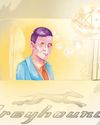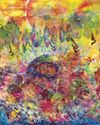
I read Friedrich Nietzsche with a mixture of admiration, amusement, outrage, and exasperation. His philosophy is the antithesis of the kind of philosophy I usually like to read and to do (that is to say, analytic philosophy), and I cannot read him for very long at a stretch. It’s like listening to a man talking at the top of his voice all the time, and it becomes wearisome. But his writing is extremely rich, stimulating, and crammed with ideas.
One particular idea of his has always intrigued me: the idea of eternal recurrence (or eternal return, as it is also known). It is a bizarre, fanciful, poetic idea, and it occurred to me that applying the methods of analytic philosophy to it might be a fruitful marriage between the analytic and the so-called Continental traditions.
Infinite Reflections
First, let’s look more closely at the idea. It’s mentioned a number of times in Nietzsche’s works. It crops up in Thus Spoke Zarathustra (1883-5), for example, where Zarathustra repeats seven times this incantation: “Oh, how should I not lust for eternity and for the wedding ring of rings – the Ring of Recurrence! Never yet did I find the woman by whom I wanted children, unless it be this woman, whom I love: for I love you, O Eternity! For I love you, O Eternity!” However, the idea is not fully examined or explored there: instead one is supposed to ponder its implications for oneself.
The fullest treatment of eternal recurrence appears in The Joyous [Gay] Science (1882):
Denne historien er fra April/May 2020-utgaven av Philosophy Now.
Start din 7-dagers gratis prøveperiode på Magzter GOLD for å få tilgang til tusenvis av utvalgte premiumhistorier og 9000+ magasiner og aviser.
Allerede abonnent ? Logg på
Denne historien er fra April/May 2020-utgaven av Philosophy Now.
Start din 7-dagers gratis prøveperiode på Magzter GOLD for å få tilgang til tusenvis av utvalgte premiumhistorier og 9000+ magasiner og aviser.
Allerede abonnent? Logg på

Metaphors & Creativity
Ignacio Gonzalez-Martinez has a flash of inspiration about the role metaphors play in creative thought.

Medieval Islam & the Nature of God
Musa Mumtaz meditates on two maverick medieval Muslim metaphysicians.

Robert Stern
talks with AmirAli Maleki about philosophy in general, and Kant and Hegel in particular.

Volney (1757-1820)
John P. Irish travels the path of a revolutionary mind.

IT'S A WONDERFUL LIFE
Becky Lee Meadows considers questions of guilt, innocence, and despair in this classic Christmas movie.

"I refute it thus"
Raymond Tallis kicks immaterialism into touch.

Cave Girl Principles
Larry Chan takes us back to the dawn of thought.

A God of Limited Power
Philip Goff grasps hold of the problem of evil and comes up with a novel solution.

A Critique of Pure Atheism
Andrew Likoudis questions the basis of some popular atheist arguments.

Exploring Atheism
Amrit Pathak gives us a run-down of the foundations of modern atheism.